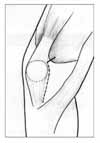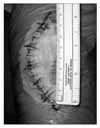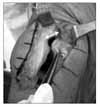Abstract
Purpose
To investigate the effectiveness of minimally invasive total knee arthroplasty using the mini-midvastus approach through analyzing the short-term clinical outcomes.
Materials and Methods
Seventy-seven consecutive total knee arthroplasties were performed with the mini-midvastus surgical technique from August 2005 to February 2006 and were followed for more than 1 year after the procedure. All operations were performed with the Nexgen LPS-flex total knee system using a MIS quad-sparing instrument. The evaluation included preoperative and postoperative clinical data, surgical and radiological outcomes.
Results
The length of skin incision was average 8.4±0.6 cm and the operation time was average 95.5±15.7 minutes. The blood loss was average 727.5±315.5 cc. The tibial component alignment angles averaged 0.2±1.3° varus and the tibiofemoral angles averaged 5.8±1.8°. The mean ROM and the mean HSS score was 117±10° and 120±11°, 88.9±7.1 and 96.2±4.5 at eight weeks and one year after surgery respectively.
Figures and Tables
 | Fig. 1The arthrotomy started from the supero-medial border of the patella followed along the medial border of the patella, and finished at the medial border of the tibial tuberosity, and added 1.5 cm to the incision parallel to the direction of the vastus medialis oblique muscle fiber to the proximal direction. |
 | Fig. 2The length of the postoperative scar was measured with the knee in full extension after wound closure. |
 | Fig. 3The length of the split vastus medialis was measured from the superomedial corner of the patella to the upper limit of the split vastus medialis. |
References
1. Bonutti PM, Neal DJ, Kester MA. Minimal incision total knee arthroplasty using the suspended leg technique. Orthopedics. 2003. 26:899–903.

2. Cooper RE Jr, Trinidad G, Buck WR. Midvastus approach in total knee arthroplasty: a description and a cadaveric study determining the distance of the popiteal artery from the patella margin of the incision. J Arthroplasty. 1999. 14:505–508.
3. Dalury DF, Dennis DA. Mini-incision total knee arthroplasty can increase risk of component malalignment. Clin Orthop Relat Res. 2005. 440:77–81.

4. Fisher DA, Watts M, Davis KE. Implant position in knee surgery: a comparison of minimally invasive, open unicompartmental, and total knee arthroplasty. J Arthroplasty. 2003. 18(7):Suppl 1. S2–S8.
5. Haas SB, Cook S, Beksac B. Minimally invasive total knee replacement through a mini midvastus approach: a comparative study. Clin Orthop Relat Res. 2004. 428:68–73.
6. Haas SB, Manitta MA, Burdick P. Minimally invasive total knee arthroplasty: the mini midvastus approach. Clin Orthop Relat Res. 2006. 452:112–116.
7. Ha CW, Ha HC. Minimally invasive vs. standard total knee arthroplasty: a prospective randomized comparison study. J Korean Orthop Assoc. 2006. 41:841–849.
8. Hernigou P, Deschamps G. Posterior slope of the tibial implant and the outcome of unicompartmental knee arthroplasty. J Bone Joint Surg Am. 2004. 86:506–511.

9. Laskin RS. Minimally invasive total knee replacement using a mini-midvastus incision technique and result. Surg Technol Int. 2004. 13:231–238.
10. Laskin RS, Beksac B, Phongjunakorn A, et al. Minimally invasive total knee replacement through a mini-midvastus incision: an outcome study. Clin Orthop Relat Res. 2004. 428:74–81.
11. Repicci JA, Eberle RW. Minimally invasive surgical technique for unicondylar knee arthroplasty. J South Orthop Assoc. 1999. 8:20–27.
12. Romanowski MR, Repicci JA. Minimally invasive unicondylar arthroplasty: eight-year follow up. J Knee Surg. 2002. 15:17–22.
13. Scuderi GR, Tenholder M, Capeci C. Surgical approaches in mini-incision total knee arthroplasty. Clin Orthop Relat Res. 2004. 428:61–67.

14. Tria AJ Jr, Coon TM. Minimal incision total knee arthroplasty: early experience. Clin Orthop Relat Res. 2003. 416:185–190.

15. Yoo JH, Han CD, Lee YT, et al. Quad-Sparing minimally invasive total knee arthroplasty. J Korean Knee Soc. 2005. 17:225–233.




 PDF
PDF ePub
ePub Citation
Citation Print
Print





 XML Download
XML Download